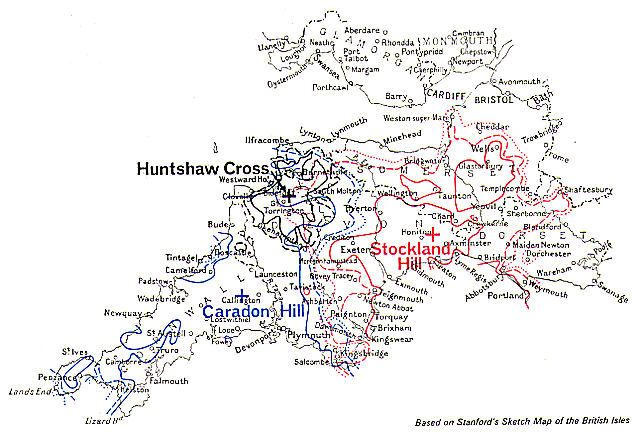 |
UK Broadcast Transmission |
|
|||||||||||
ITV 405 line VHF TV TRANSMITTERS
SOUTH-WEST ENGLAND
| CARADON HILL | STOCKLAND HILL | Huntshaw Cross | |
| Channel / Polarisation | 12 V | 9 V | 11 H |
| Max. Vision ERP | 200 kW | 100 kW | 0.5 kW |
| Site ASL | 1211 ft | 750 ft | 658 ft |
| Aerial ASL | 1936 ft | 1475 ft | 1130 ft |
| Location (NGR) | SX 274708 | ST 223015 | SS 527220 |

South-west England was served by three of the Authority's stations, Caradon Hill in Cornwall, Stockland Hill in Devon, and a relay station at Huntshaw Cross which provided an improved service in the Barnstaple/Bideford area. Propagation studies of the best method of covering the 150 mile long wedge-shaped area of Devon and Cornwall showed that it was not practical to serve it adequately from a single Band III station centrally situated on the heights of Dartmoor, adjacent to the BBC's station at North Hessary Tor. Government agreement was obtained to build two stations, one in Cornwall and one in South Devon, another necessary departure from the principle of co-siting with the BBC Band I station. High sites were found at Caradon Hill, near Launceston, for Cornwall; and Stockland Hill, near Axminster, for Devon. Transmitting aerials with highly-directional lobes were engineered to give the desired grade of service to both areas while minimizing interference with other ITA and Continental stations which use the same channels. Each station needed a 750 ft mast to minimize 'shadows' in this hilly terrain. For Caradon Hill, the requirement was to give a service to the whole of Cornwall west of Dartmoor and reaching to Land's End. A power of 200 kW e.r.p. was beamed in this direction but to avoid interference in the service area of the Dublin station the power over an arc of 40° to the north-west had to be restricted to a mere l0 kW, while to the south the power had to be restricted to 25 kW to avoid interference in the service area of the Cherbourg station. Studies showed that in order to cover Devon while not overlapping unnecessarily with the existing service area of St Hilary, Stockland Hill should direct its maximum power in two lobes, one north-west towards Barnstaple and the other south-west towards Dartmouth. l00 kW was the maximum permissible radiated power but restriction to 10 kW eastwards was necessary to prevent interference in the London area, which also uses Channel 9. The shape of the aerial radiation pattern thus became that of a boomerang facing westwards. A subsidiary beam of about 50 kW directed south-east towards the island of Alderney would allow the mainland programmes picked up there to be relayed by Post Office microwave link to the Fremont Point station in Jersey for rebroadcasting in the Channel Islands. However, in order to protect the service area of the existing French station at Bourges the power radiated towards Alderney had to be restricted to 20 kW. This power was, in practice, just sufficient for the Stockland Hill signal to be received in Alderney, with a signal to noise ratio good enough for rebroadcasting from Fremont Point. Both stations went into service on 29 April 1961 and provided coverage throughout almost the whole area. One small area near the northern coast around Westward Ho!, however, was not well served and relay station at Huntshaw Cross served this area, with a service date of 22 April 1968. |
|